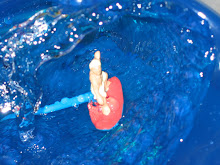A Photomontage - Travelling on Highway 1A, Vietnam
In Vietnam, everything that would be transported by a car or truck in the United States is transported just the same, although not in a car or truck. The bike is the most common form or transportation. Bicycles are ridden by students (who can't ride a motobai yet), by teenagers (who can't afford a motobai), by adults, and by the grandparents. Since stuff needs to be transported, the Vietnamese use the only wheels that they have and those wheels (of which there are only two) are bicycle wheels. Or maybe two motobai wheels.
Taking the Birds to Market.

An Umbrella Can Be Used to Protect from Rain or Shine.

Another Design - The Basket Bike. Useful for Carrying Fruit or Fish.

Two Basket Bike Buddies Breaking.

To my eye, Vietnam was a dirty place. Terry reassures me that this is typical of third-world countries, but I'm not reassured. Typically, the Vietnamese throw their garbage on the curb and the municipal sweeping crew comes by once or twice a day (typically at 2 a.m.) and picks up the garbage. But in the villages and countryside there is no one to pick up the garbage, but garbage is still left on the side of the road or just about anywhere.
Having an environment covered in garbage doesn't mean that other aspects of the country are dirty. The Vietnamese seem more "in touch" with their environment. By more in touch I mean that there is more dirt and more wildlife, more vegetation. This earthiness, as I will call it, caused a culture shock in me. I realized that I expect a cleaner environment, actually, compared to Vietnam, my environment back home is sterile. Cleanliness is taken to such an extreme that we have sterilized much of our Western world.
Regardless of the lack of sterile environment and the fact that goods are transported by bicycle (and motobai) instead of automobile, people are still the same. Some people like to party, others want to work. Some people are farmers and others work behind a desk or in a store. Some people are teachers and others are soldiers. Some are slobs and then some very organized.
For example, take the following picture. This vendor has a very well organized bike. Her washing and cooking pans are piled up on the tap of the back rack. The vegetables are placed in her left back basket, while the right basked contains meat and seafood. Hanging from the handlebars is a rubber bag containing today's newspaper and other items such as a rain slicker. She is wearing her hat and has a very comfortable riding stance. In all, she is ready for a good day of cooking and selling her goods.

In the next picture, you will notice the old man with his hunched shoulders. But did you notice the woman riding the other direction (i.e. she's riding the wrong way)? Most people would ride on the correct side of the road following the same driving convention as United States drivers - riding on the right hand of the road. But, when one wanted to turn off of the road, people would just aim towards their destination. If that meant that they would turn early and ride on the wrong side of the road(or motorbike or...), then they would have to ride against the traffic for a few yards. During each day's ride, I would have to navigate around these cyclists (and motorbikes) who were using the wrong side of the road. I never had a problem, but it was disconcerting at first.

Compare and Contrast: Western Cyclist and Vietnamese Ox Cart.

The Road Seems Calm and Quiet Right Now, but Wait...

...Wait Until a Bus Passes.

Fortunately, Highway 1A has a very wide shoulder. As you can see in the previous picture, a bus can pass other vehicles, yet there is still plenty of room for the bicycles and scooters on the edge of the road. We typically rode on the part of roadway (that is slightly dirty) betwen the dirty shoulder and the central part of the road, but we sometimes swerved off into the dirty shoulder when vehicles passed from the other direction. We had no other choice, unless we preferred being run over by a noisy honking bus coming the other way.

Sitting in the Grassy Highway Median.

Most Vietnamese now wear bicycle helmets, though not all do.

During a typical day's ride, we pass 20 or so communist monuments. Typically these monuments are rememberance of past battles or struggles to become an industrialized communist country. They all were bland, most included both a male and female character, and I never saw anyone inside the monument grounds.

Statue of the Vietnamese National Hero (and former Emporer), Le Loi (taken as we Turned West Towards Sam So'n)

Vietnamese language is often written piece-by-piece on billboards. Instead of shortening the message, using a smaller font, or using a square billboard, the message is written out in large letters. This means that the communist billboards containing words often stretch and stretch. Some might stretch for a large part of a city block.

Terry Repairing a Flat as Many Watch.

These rocks have special powers because of their unique shape.


Today's destination was Sam S'on. A typhoon had come through town a week earlier. The fishing boats were moved by the storm inland. When we arrived in town, some of those boats had not been moved back to the beach.

When shopping for a hotel for that night, I saw this excessively cute puppy. In some parts of Vietnam, it is common to eat the family pet. Hopefully this guy has a full life and a natural death. Almost every house we passed had a family dog.

Day 48 - Nihn Binh to Sam Son - 53 Miles

No comments:
Post a Comment